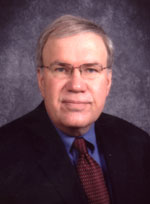Catholic Education Outreach / G. Joseph Peters
Why the president-principal model is good for Catholic high schools
 (Editor’s note: The following is the first of a new bimonthly column provided by the archdiocesan Office of Catholic Education.)
(Editor’s note: The following is the first of a new bimonthly column provided by the archdiocesan Office of Catholic Education.)
The president-principal model of
high school administration was first introduced in archdiocesan interparochial high schools in the mid-1990s as a result of recommendations from an institutional assessment by Catholic School Management Inc. and subsequent consultations in the schools.
Five of the seven interparochial high schools now have presidents and principals, as do all four of the private Catholic high schools located within the archdiocese. The two smallest high schools in the archdiocese operate with principals as chief executives.
The model recognizes that there are two separate and distinct jobs for top administrators in all Catholic high schools today. In simple terms, one mainly involves the future of the school and the other focuses on the day-to-day operations.
Principals are necessarily consumed by the daily responsibilities of running the school, and responsibilities for advancing the institution can be neglected to the detriment of the long-term health of the school. Likewise, advancement goals can be met while the educational side suffers.
In business terms, the president is seen as the “external officer” and chief executive (CEO) and the principal is the “internal” or chief operating officer (COO).
The president serves as the executive officer of the board, oversees the overall mission and Catholic identity of the school, leads strategic long-term planning with the board, leads institutional advancement (development) efforts and the business affairs of the school.
The principal provides leadership for faith community affairs, academic affairs and student affairs. The roles are discrete, but the model works best when the president and principal collaborate closely and have a united vision of what the school should be. Of course, they must both share responsibility for the over-arching mission of a Catholic school in passing on the faith.
The president-principal model first appeared in Jesuit high schools. Recent reports indicate that more than 50 percent of Catholic secondary schools in the U.S. now employ the president-principal model of administration and another 14 percent anticipate changing to the model within the next few years.
This administrative structure may not be feasible in the smallest Catholic high schools, but the board and administration of these schools must make effective provision for both the internal and external, or “presidential” functions, if a school is to be successful and viable today. Several research studies have validated the efficacy of the model.
Gone is the day when the principal returned to work a few days before school started, students were lined up around the block on the first day of classes, and funding was mostly from a “living endowment” of religious sisters and brothers, who worked for little or no pay.
Catholic high schools today—even the smallest—are multi-million dollar business operations that must be professionally lead, managed and marketed for image, enrollment and financial resources in order to not just survive, but to thrive.
We believe that the president-principal model has helped Catholic interparochial high schools in the archdiocese become the successful institutions that they are today. There is no question that the model, along with strong leadership by the high school boards and the people in the top administrative positions, have made institutional advancement efforts more successful in the schools.
(G. Joseph Peters is the archdiocesan associate executive director for Catholic Education.) †
 (Editor’s note: The following is the first of a new bimonthly column provided by the archdiocesan
(Editor’s note: The following is the first of a new bimonthly column provided by the archdiocesan